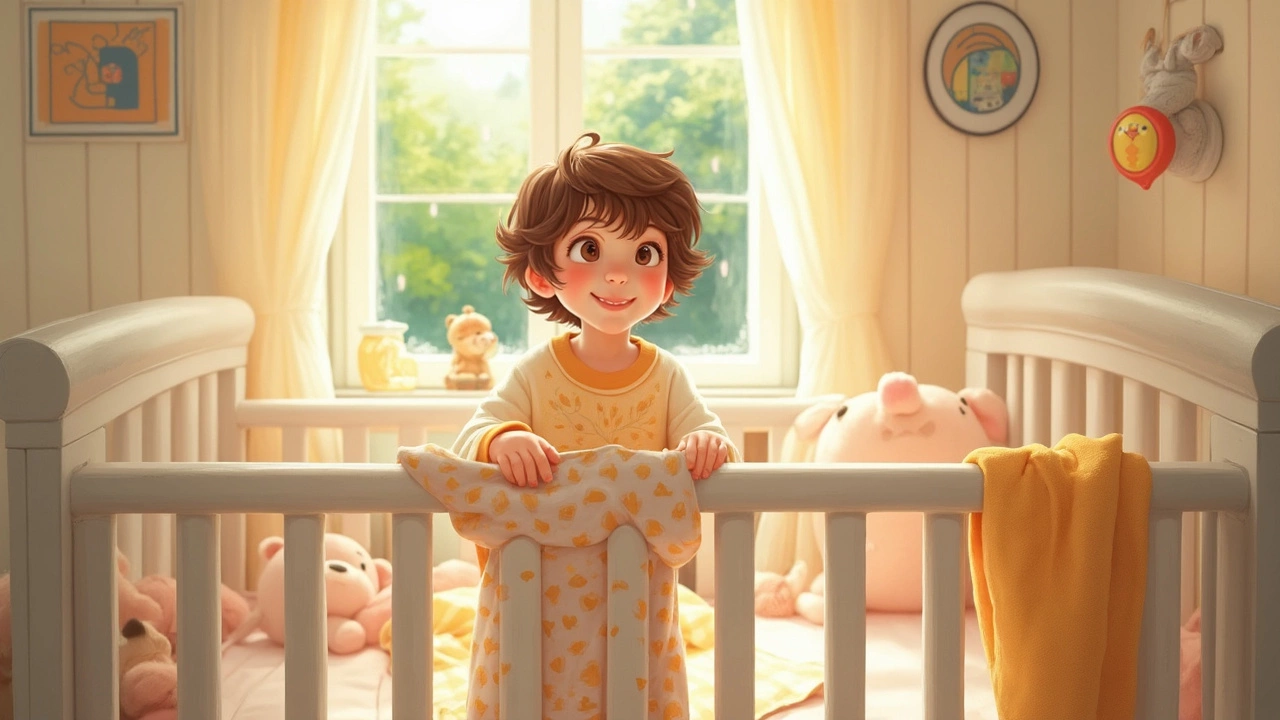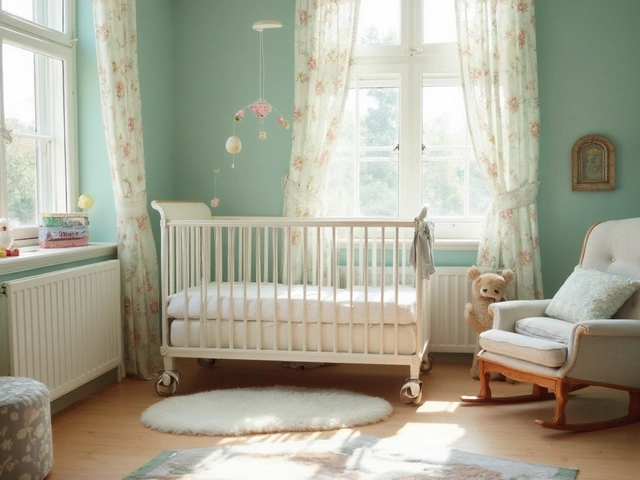
Ever peeked in at night and wondered when your kid will finally stop looking like a cozy burrito? If you're using a sleep sack, you're not alone. They're like a baby sleeping bag – warm, secure, and you don’t have to stress about loose bedding dangers.
But there comes a time when you start thinking, shouldn’t they be using a ‘real’ blanket? Is there some magic age—or is it all about your child’s needs? The truth is, every toddler is different, but there are some solid guidelines and clear signs that can help you decide when to make the move.
No parent wants to jump the gun or wait too long. Too early, and your little one may kick off the blanket and wake up chilly. Too late, and you might be holding onto the sleep sack just out of habit. This transition might sound small, but it can mean better sleep for you and your toddler, plus, a sense of big-kid pride for them.
- Why Toddlers Use Sleep Sacks
- When Most Toddlers Are Ready for Blankets
- Key Signs Your Child Can Switch
- Safe Transition Tips
- Choosing the Right First Blanket
- Common Parent Questions Answered
Why Toddlers Use Sleep Sacks
There’s a reason so many parents swear by sleep sacks for toddlers—they keep kids safe and comfy. Unlike loose blankets, which can ride up and accidentally cover a child’s face, sleep sacks stay put all night. This reduces the risk of suffocation and creates a cozy sleep environment.
Pediatricians and sleep experts often push for sleep sacks, especially before age two. According to the American Academy of Pediatrics, you shouldn’t put loose blankets in a crib for babies under 12 months because of the risk of Sudden Infant Death Syndrome (SIDS). That said, most toddlers keep using sleep sacks until at least 18–24 months—sometimes a bit longer if it works for the kid.
“Sleep sacks provide a safe and comfortable alternative to traditional blankets—they help regulate body temperature and minimize hazards in the crib,” says Dr. Jennifer Shu, pediatrician and spokesperson for the American Academy of Pediatrics.
But it’s not just about safety. Little kids move a lot in their sleep and often kick off typical blankets. With a sleep sack, you know your toddler won’t end up freezing by morning. This can help prevent midnight wake-ups caused by being too cold.
On top of that, many toddlers find the snug fit of a sleep sack calming, almost like a little sleeping hug. This sense of security can make bedtime easier and help with sleep routines—especially if your toddler is transitioning from a crib to a toddler bed.
- Sleep sacks lower the risk of suffocation compared to blankets
- They help keep toddlers’ temperatures steady
- They stay in place—no more kicked-off blankets
- Many kids sleep better with that cozy, enclosed feeling
| Age Group | Recommended Bedding |
|---|---|
| Under 1 year | Sleep sack or wearable blanket only |
| 1-2 years | Mostly sleep sack, start monitoring readiness for blankets |
| 2 years and above | Transition to toddler blanket as ready |
If you’re questioning whether you need to bother with a sleep sack past infancy, there you have it: safety, warmth, and fewer middle-of-the-night covers to readjust.
When Most Toddlers Are Ready for Blankets
Most parents switch from a sleep sack to a toddler blanket around 18 months to 2 years old. This is the age where a lot of kids have outgrown their crib or are about to make the jump to a toddler bed. It’s not just about age though—the key thing here is physical development. By this time, most toddlers have the strength and coordination to pull a blanket up if they get cold or kick it off if they get hot. That helps keep them safe and comfy through the night.
The American Academy of Pediatrics says soft bedding—including loose blankets—should be kept out of the crib until at least 12 months, but most parents hold off even longer because rolling and moving under a blanket is a new skill. By about 18 months, the risk for suffocation or entrapment drops because your kiddo can move around much better.
Here’s a quick breakdown of when parents usually make the switch:
- Around 18 months: Some early movers start using a blanket, especially if they sleep in a toddler bed.
- 20-24 months: This is the most common age range for switching.
- After 2 years: Some kids love their sleep sack and stick with it even after their second or third birthday. That’s okay too.
If your toddler is still in a crib, you can wait a bit longer. But if they’re climbing out or you’ve moved them to a toddler bed, a blanket can help them feel like a "big kid."
| Age | Common Bedding | Sleep Environment |
|---|---|---|
| 0-12 months | No blankets (sleep sacks only) | Crib |
| 12-18 months | Mainly sleep sacks | Crib or transition to toddler bed |
| 18-24 months | Sleep sacks or blankets | Toddler bed becoming more common |
| 2+ years | Blankets preferred | Toddler bed or open bed |
If you’re feeling unsure, don’t rush. Pay attention to your child’s motor skills, sleeping position, and habits. The goal is to make the bedtime switch when your child is both safe and ready for a toddler blanket.
Key Signs Your Child Can Switch
If you’re looking for a checklist before ditching the sleep sack, you’re not alone. There isn’t a one-size-fits-all age, but most toddlers show pretty clear signs when they’re ready to make the leap to using a toddler blanket.
Usually, you’ll notice these signals between 18 months and 3 years, but the pace depends on your little one’s personality and sleep style. Here’s what to watch for:
- Mobility in Bed: Your child can get in and out of their toddler bed safely—major clue they can handle a blanket too.
- Discomfort With the Sleep Sack: Is your toddler trying to wriggle out, unzip, or kick off their sleep sack? That’s a classic "I’m ready for something new" move.
- Interest in Blankets: Some kids start asking for a blanket or show curiosity when they see you using one. If your toddler tries pulling a blanket onto themselves, that’s a green light.
- Temperature Control: Your child can remove or adjust bedding if they’re hot or cold. This shows they can manage a toddler blanket overnight.
- Consistent Sleep Patterns: Once your toddler sleeps through the night reliably, they’re less likely to get tangled or be woken up by a kicked-off blanket.
Here’s a quick table showing when parents usually see these milestones pop up:
| Sign | Common Age Range |
|---|---|
| Climbing in and out of bed | 18-30 months |
| Unzipping or escaping sleep sack | Around 2 years |
| Removing/adjusting bedding | 2-3 years |
| Sleeping through the night | By 2.5 years |
One thing nobody really talks about: sometimes your toddler just outgrows the largest sleep sack sizes, so you pretty much have to switch. But if your child is still cozy and happy in their sleep sack, there’s no rush. Safety and comfort come first, so trust your instincts as much as the checklist.

Safe Transition Tips
Switching from a sleep sack to a blanket is a big move, and making it smooth and safe is easier if you have a plan. The key thing to remember is that safety comes first—especially for kids under 2, since loose blankets can up the risk of suffocation. Most pediatricians and the American Academy of Pediatrics say blankets are safest after age 1, but waiting until 18 months to 2 years can add some extra peace of mind if your toddler is a wild sleeper.
Here’s how you can help your child ease into blanket life without drama:
- Start slow. Try using the blanket for naps before switching overnight. This helps your toddler get used to the feel of it without messing up a full night of sleep.
- Keep the sleep sack handy as a backup. Some kids need extra time or want the sack for a few nights if they get chilly or unsettled.
- Choose a thin, lightweight toddler blanket to keep things safe. Thick, heavy blankets can overheat your child or tangle more easily.
- Stick with one blanket at first. Multiple blankets are unnecessary and just make things riskier for younger toddlers.
- Give your toddler some say in the process. Let them help pick out their new blanket (even if it means bright cartoon prints), so they feel involved and excited.
- Keep the rest of the crib or toddler bed clear. Stuffed animals or pillows should be minimal so there’s less clutter to get wrapped up in.
- Ask yourself if your child can kick off or pull on the blanket easily. If not, maybe stick with the sleep sack for another month or two.
Not sure what other parents do? One 2023 survey saw most families making the switch between 18 and 24 months. No big surprise since that’s when kids are sturdier and strong enough to adjust their own blanket during the night.
If you’re working with a toddler bed instead of a crib, you have a little more wiggle room since your child can get in and out independently. Just make sure the blanket isn’t too big or dragging on the floor.
Bottom line: go at your toddler’s pace. There’s no gold medal for the earliest switch, but plenty of comfort (and safer sleep) if you do it when your kid is truly ready.
Choosing the Right First Blanket
This is where things get real. Not every blanket is safe or comfy for a toddler. Grab the wrong one, and you’ll be up in the middle of the night fixing it—or worse, dealing with safety issues. Here’s what you really need to know when picking your child’s first "big kid" blanket.
First up, size really matters. Go for a toddler-sized blanket, usually about 40 x 60 inches. Anything too big can bunch up and end up over their face. Anything too small won’t keep them covered.
- Material: 100% cotton is your best friend. It breathes well, keeps little ones warm but won't overheat them, and is washable. Fleece blankets are cozy but can sometimes be too warm, especially if your home runs hot.
- Weight: Keep it light. Heavy blankets are a no-go for toddlers. You want something they can kick off easily if they get too warm. Most experts recommend lightweight, single-layer blankets at this stage.
- Safety first: Skip anything with loose threads, buttons, or decorations that could come off. The blanket should be fitted for your child’s size—no dragging edges or huge folds.
- Easy care: You’ll be washing this thing a lot, so pick something that holds up in the washer and dryer.
- Familiarity helps: Let your toddler help pick the print or color. If they’re excited about it, bedtime is already a little easier!
Here’s a quick look at what most parents choose for their child’s first toddler blanket:
| Type | Material | Recommended Age | Common Size |
|---|---|---|---|
| Lightweight Cotton | 100% Cotton | 18 months+ | 40x60" |
| Quilted Blanket | Poly-cotton Blend | 2 years+ | 36x48" |
| Lightweight Fleece | Polyester | 2 years+ | 40x50" |
And if you’re ever unsure, check the manufacturer’s guidance or go with products labeled "safe for toddlers." Trust your gut. If the blanket seems too bulky, loose, or just not quite right, keep looking. Your toddler’s comfort and safety are worth it!
Common Parent Questions Answered
Switching from a sleep sack to a blanket sounds easy...until you start thinking about all the little details. Here are straight-up answers to questions that get asked over and over by parents in the toddler years.
1. What age is safest for starting with a blanket? Most experts and the American Academy of Pediatrics (AAP) say it's safest to hold off on loose blankets until at least 12 months. But honestly, lots of parents wait until 18 months to 2 years, especially if their toddler is still comfy in a sleep sack. Safety always comes first, so don’t feel rushed.
“To reduce the risk of sudden infant death syndrome (SIDS), keep soft bedding like blankets out of your child’s sleep space for the first year. After 12 months, you can introduce a lightweight blanket if your child is ready.” – American Academy of Pediatrics
2. Is my toddler too old for a sleep sack? Nope. There’s actually no hard age limit. Some kids love their sleep sack until they’re three. As long as it fits safely (think no tight neck holes or dragging fabric), you can stick with it until your toddler is ready for a change.
3. My child kicks off blankets—how do I keep them warm? This is super common. Toddlers are wiggly. You can try footed pajamas, layering up (but not too much), or sticking with a sleep sack for a bit longer. If you do move to a blanket, look for ones meant for toddlers: not too heavy, not too big, easy to wash.
4. How do I pick the right first blanket? Go for a toddler-sized blanket. They’re usually around 40x60 inches or smaller. Fleece, cotton, or muslin gets softer after every wash. Avoid quilts or anything bulky for young toddlers. Skip weighted blankets unless your pediatrician specifically recommends one.
5. Any stats on what parents are actually doing? Check out the table below for a quick look at what other families choose.
| Transition Age | % of Parents |
|---|---|
| 12-18 months | 35% |
| 18-24 months | 45% |
| After 2 years | 20% |
It’s clear most make the switch somewhere in the 18-24 month range—but do what feels right for your child and sleep situation.
6. Can my toddler have pillows and stuffed animals too? Pillows are usually safe around 18-24 months, but make sure they’re small and firm. A favorite stuffed animal is okay as long as it isn’t massive and doesn’t pose a suffocation risk. Watch for any sleep disruptions with new stuff in the bed.
Last tip: Trust your gut. Watch your child and what helps them sleep best. Check in with your pediatrician if you’re ever unsure—no question is too small when it comes to your little one’s safety and sleep.







Write a comment